Related Research Articles
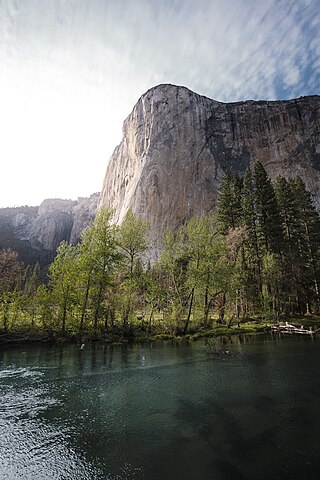
El Capitan is a vertical rock formation in Yosemite National Park, on the north side of Yosemite Valley, near its western end. The granite monolith is about 3,000 feet (914 m) from base to summit along its tallest face and is a world-famous location for big wall climbing, including the disciplines of aid climbing, free climbing, and more recently for free solo climbing.

Alexander Huber, is a German rock climber who is considered one of the greatest and most influential climbers in the history of rock climbing. Huber came to prominence in the early-1990s as the world's strongest sport climber after the passing of Wolfgang Güllich; he was the second-ever person to redpoint a 9a (5.14d) graded route with his 1992 ascent of Om, and has latterly come to be known as the first-ever person to redpoint a 9a+ (5.15a) graded route with this 1996 ascent of Open Air.
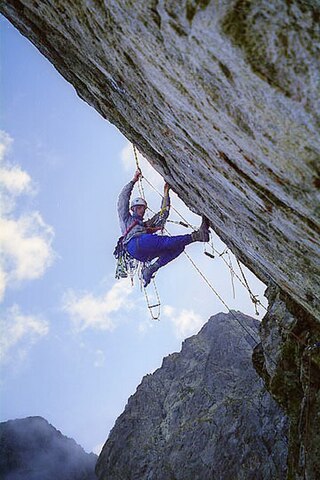
Aid climbing is a form of rock climbing that uses mechanical devices and equipment, such as aiders, for upward momentum. Aid climbing is the opposite of free climbing, which only uses mechanical equipment for protection, but not to assist in upward momentum. "Traditional aid climbing" involves hammering in permanently fixed pitons and bolts, into which aiders are clipped, whereas "clean aid climbing" avoids hammering, using only removable placements.
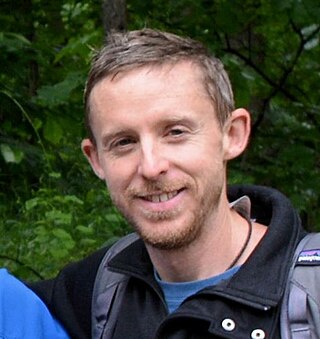
Tommy Caldwell is an American rock climber who has set records in sport climbing, traditional climbing, and in big-wall climbing. Caldwell made the first free ascents of several major routes on El Capitan in Yosemite National Park.
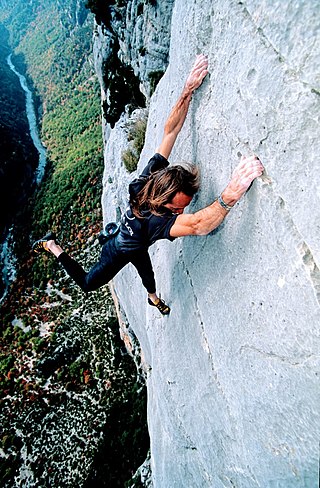
Free solo climbing, or free soloing, is a form of rock climbing where the climbers climb solo without ropes or other protective equipment, using only their climbing shoes and their climbing chalk. Free soloing is the most dangerous form of climbing, and, unlike bouldering, free soloists climb above safe heights, where a fall can be fatal. Though many climbers have free soloed climbing grades they are very comfortable on, only a tiny group free solo regularly, and at grades closer to the limit of their abilities.

In the history of rock climbing, the three main sub-disciplines—bouldering, single-pitch climbing, and big wall climbing—can trace their origins to late 19th-century Europe. Bouldering started in Fontainebleau, and was advanced by Pierre Allain in the 1930s, and John Gill in the 1950s. Big wall climbing started in the Dolomites, and was spread across the Alps in the 1930s by climbers such as Emilio Comici and Riccardo Cassin, and in the 1950s by Walter Bonatti, before reaching Yosemite where it was led in the 1950s to 1970s by climbers such as Royal Robbins. Single-pitch climbing started pre-1900 in both the Lake District and in Saxony, and by the late-1970s had spread widely with climbers such as Ron Fawcett (Britain), Bernd Arnold (Germany), Patrick Berhault (France), Ron Kauk and John Bachar (USA).
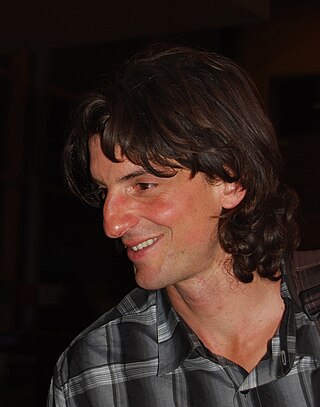
Dean Spaulding Potter was an American free climber, alpinist, BASE jumper, and highliner. He completed many hard first ascents, free solo ascents, speed ascents, and enchainments in Yosemite National Park and Patagonia. In 2015, he died in a wingsuit flying accident in Yosemite National Park.

Stephanie "Steph" Davis is an American rock climber, BASE jumper, and wingsuit flyer. She is one of the world's leading climbers, having completed some of the hardest routes in the world. She has free soloed up to 5.11a (6b+), and was the first woman to summit all the peaks of the Fitzroy Range in Patagonia, the second woman to free climb El Capitan in a day, the first woman to free climb the Salathė Wall on El Capitan, the first woman to free solo The Diamond on Longs Peak in Colorado, and the first woman to summit Torre Egger. Davis was married to fellow climbers and BASE jumpers Dean Potter and Mario Richard, and currently to sky-diving instructor, flyer, and jumper Ian Mitchard. Davis is also a blogger who writes about her interests in climbing, BASE jumping, yoga, and veganism.

Big wall climbing is a form of rock climbing that takes place on long multi-pitch routes that normally require a full day, if not several days, to ascend. Big wall routes are typically sustained and exposed, where the climbers remain suspended from the rock face, even sleeping hanging from the face, with limited options to sit down or escape unless they abseil back down the whole route. It is therefore a physically and mentally demanding form of climbing.

The Nose is a big wall climbing route up El Capitan. Once considered impossible to climb, El Capitan is now the standard for big wall climbing. It is recognized in the historic climbing text Fifty Classic Climbs of North America and considered a classic around the world.

The Salathé Wall is one of the original big wall climbing routes up El Capitan, a 3,000-foot (900 m) high granite monolith in Yosemite National Park. The Salathé Wall was named by Yvon Chouinard in honor of John Salathé, a pioneer of rock climbing in Yosemite. The route is recognized in the historic climbing text Fifty Classic Climbs of North America and is considered a classic around the world.
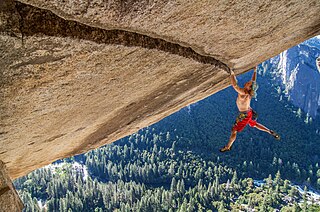
Separate Reality is a 66-foot (20 m) traditional climbing route in Yosemite National Park in California. The route is known for its exposed and dramatic crux that consists of a 20-foot (6.1 m) long crack in its horizontal roof. When it was first free-climbed by Ron Kauk in 1978, it was one of the first climbs in the world to have a grade of 7a+ (5.12a). In 1986, German climber Wolfgang Güllich free soloed the route, and the photographs by Austrian Heinz Zak become iconic in rock climbing history.

Alex Honnold is an American rock climber best known for his free solo ascents of big walls. Honnold rose to worldwide fame in June 2017 when he became the first person to free solo a route on El Capitan in Yosemite National Park, a climb described in the New York Times as "one of the great athletic feats of any kind, ever." Honnold also holds the record for the fastest ascent of the "Yosemite Triple Crown", an 18-hour, 50-minute link-up of Mount Watkins, The Nose, and the Regular Northwest Face of Half Dome. In 2015, he won a Piolet d'Or in alpine climbing with Tommy Caldwell for their completion of the enchainment of the Cerro Chaltén Group in Patagonia over 5 days.

Ines Papert is a German alpine climber, and a world champion ice and mixed climber best known for her competition ice climbing awards and difficult alpine ascents. She has made a number of first ascents and has broken difficulty grade milestones for female climbers.
Libby Sauter is an American mountaineer, rock climber, and pediatric cardiac intensive care nurse educator. Sauter and her climbing partner, Mayan Smith-Gobat, set the women's speed record climbing The Nose on El Capitan, in 2014. In 2017, she became the youngest woman inducted into the American Alpine Club Hall of Fame. In 2007, she became the first woman to walk the Lost Arrow Spire highline.

Emily Harrington is an American professional rock climber and mountaineer. She is a five-time US National Champion in sport lead climbing, runner-up in the 2005 IFSC Climbing World Championships, and has made the first female free ascents of several 5.14 (8c/+) routes.
Brette Harrington is an American professional rock climber and alpinist based in Lake Tahoe, California and British Columbia, Canada. She was featured in the 2021 film The Alpinist alongside her late partner, Marc-André Leclerc. She is best known for the first free solo of the 760 meter (2,500-foot) Chiaro di Luna (5.11a) in Patagonia, for her development of new alpine climbing routes, and as the star of Brette, a Reel Rock Film Tour short film.
Marc-André Leclerc was a Canadian rock climber, ice and mixed climber, and alpinist. He is known for his solo ascents–often in winter–of major ice and alpine climbing routes. In 2016, he completed the first winter solo ascents of both Torre Egger in Patagonia and of the Emperor Face of Mount Robson in Canada. In 2018, he was killed in an avalanche on the Mendenhall Towers in Alaska.

The Alpinist is a 2021 American documentary film directed by Peter Mortimer and Nick Rosen about Marc-André Leclerc, a free-spirited and little-known 23-year-old Canadian rock climber, ice climber, and alpinist. From 2015 to 2016, a film crew followed Leclerc as he solo climbed some of the most difficult and dangerous alpine climbing routes in the world.
References
- 1 2 Laeser, Luke. "New Zealand's Mayan Smith-Gobat". Climbing Magazine. Retrieved 28 March 2019.
- ↑ "Mayan Smith-Gobat interview". PlanetMountain.
- ↑ "Mayan Smith-Gobat: Climber For All Seasons". Rock and Ice.
- ↑ "Mayan Smith-Gobat, first female ascent of Punks in the Gym at Arapiles". PlanetMountain.com. Retrieved 28 March 2019.
- ↑ "Salathe Wall". Mayan Smith-Gobat. Retrieved 31 March 2019.
- 1 2 Fox, Amanda. "Mayan Gobat-Smith Frees Salathé Wall". Climbing Magazine. Retrieved 31 March 2019.
- ↑ "Mayan Smith-Gobat climbs The Salathé Wall on El Capitan". PlanetMountain.com. Retrieved 28 March 2019.
- ↑ "Walls Without Balls: All Women Big Wall Ascents". cruxcrush.com. Retrieved 28 March 2019.
- ↑ "climbing : Smith-Gobat and Astorga's records in Yosemite Valley". www.climbandmore.com. Retrieved 28 March 2019.
- ↑ "Adidas Five Ten | Speed Climbing is Addictive - Mayan Smith-Gobat | adidasoutdoor". www.adidasoutdoor.com. Retrieved 28 March 2019.
- 1 2 "Yosemite Hardwomen: An El Cap Speed Ascent Debrief - Alpinist.com". www.alpinist.com. Retrieved 28 March 2019.
- ↑ Video: Speed Climbing El Cap Is a Game of Micro Improvements, 12 July 2018, retrieved 28 March 2019
- 1 2 3 "RIDERS ON THE STORM" . Retrieved 29 March 2019.
- 1 2 3 "News - Petzl Patagonia: Mayan Smith-Gobat tests her mettle on "Riders on the Storm" - Petzl USA". www.petzl.com. Retrieved 29 March 2019.
- ↑ "Torres del Paine in Patagonia: Riders on the Storm too stormy for Mayan Smith-Gobat and Brette Harrington". PlanetMountain.com. Retrieved 29 March 2019.
- ↑ "Riders on the Storm, Central Tower East Face, Torres del Paine, Patagonia - climbing, rock". www.planetmountain.com. Retrieved 29 March 2019.
- ↑ Smith-Gobat, Mayan. "That One Time: The Ultimate Training Day". Climbing Magazine. Retrieved 29 March 2019.
- ↑ Andrew Bisharat (30 June 2016). "Brette Harrington's Solo Soul Serenity". Evening Sends. Retrieved 29 March 2019.
- 1 2 "Riding the Storm on Torre Central, Patagonia - Alpinist.com". www.alpinist.com. Retrieved 29 March 2019.
- ↑ "Blog - Brette Harrington - Riders on the Storm". www.sportiva.com. Retrieved 29 March 2019.
- ↑ Germany, Norbayerischer Kurier. "Weltklasse-Kletterin: Mayan Smith-Gobat lässt sich in Plankenfels nieder - Nordbayerischer Kurier". www.nordbayerischer-kurier.de (in German). Retrieved 29 March 2019.
- ↑ "Brette Harrington and Rose Pearson follow their 'Life Compass' to complete a new route in a 21.5-hour push in the Canadian Rockies - Alpinist.com". www.alpinist.com. Retrieved 29 March 2019.